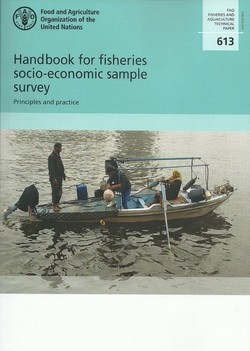
FAO Fisheries and Agriculture Technical Paper 613
Handbook for Fisheries Socio-economic Sample Survey
Principles and Practice
By
Dario Pinello, Jennifer Gee and Mark Dimech
Rome, 2017
Abstract
Socio-economic data are a key component of the scientific advice required for the evidence-based management of fisheries, yet in many countries these data are limited, usually because of a lack of technical capacity for their collection.
The handbook consists of three parts: an introduction to the theory behind setting up a survey; a comprehensive explanation of the data collection process, including a section on operational steps; and an explanation of how to use indicators to interpret and present the results of a sample survey to stakeholders, and monitor the fishery.
Making use of one of the most straightforward sampling schemes available, the handbook guarantees that, if the methodology is correctly applied, statistically sound and robust fisheries data will be produced. It’s simple statistical methodology does not require a great deal of resources, allowing adequate resources to be applied to other crucial elements of establishing a robust data collection process, such as selecting the right people; conducting proper training; and developing the capacity of people so as to ensure good data quality.
This handbook was prepared partially as a response to a request from the Scientific Advisory Committee (SAC) of the General Fisheries Commission for the Mediterranean (GFM). The field implementation of the methodology has been conducted by the Food and Agriculture Organization of the United Nations (FAO) through the FAO Mediterranean Fisheries Management Support Projects (AdriaMed, CopeMed EastMed and MedSudMed), and further tested, adapted and developed, through the Project “EastMed” (Scientific and Institutional Cooperation to Support Responsible Fisheries in the Eastern Mediterranean).Although the handbook was developed through work in the Mediterranean, the methodology is globally applicable and it provides a valuable opportunity for countries to establish a self-sufficient, routine socio-economic data collection programme that facilitates the improved planning, monitoring and management of fisheries.
Contents
Part 1: Background and Theoretical
<!--Introduction
<!--Setting up the survey
Part 2: Practice: Data Collection Process
<!--Sampling design
<!--Collecting the data
<!--Quality check and treatment of the data
<!--Estimations from the sample to the total population
<!--Operational steps & practical advice for execution in spreadsheets
Part 3: Transforming Inputs into Statistics
<!--[if !supportLists]--> · Indicators: Interpreting the results & disseminating information
<!--Example of data presentation and utilization



ساحة النقاش